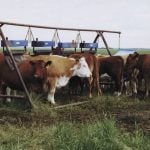The federal government has expanded its list of designated areas into three more provinces where livestock producers are now eligible for income tax deferrals, because of the effect of dry conditions on forage yields.
The deferrals, announced Thursday, are meant to allow producers to defer income tax on the sale of breeding livestock for a year, to help replenish breeding stock in the following year.
Proceeds from deferred sales are included as income in the next tax year, when they may be at least partially offset by the cost of replacing breeding animals. In the case of consecutive years of designation, producers may defer sales income to the first year in which the area is no longer designated.
Read Also

Europe, North America face early wave of bird flu cases
An unusually early outbreak of bird flu cases affecting high numbers of wild birds and poultry farms across Europe and North America is raising concerns of a repeat of previous crises that led to mass culling and food price spikes.
To defer income, a breeding herd must have been reduced by at least 15 per cent. If this is the case, 30 per cent of income from net sales can then be deferred. In cases where the herd has been reduced by more than 30 per cent, 90 per cent of income from net sales can be deferred.
The new deferrals for the 2012 tax year apply in designated areas in British Columbia, Alberta, Manitoba, Ontario and Quebec.
In Ontario, where some designations were already made in August, the jurisdictions added Thursday include the District of Rainy River, the territorial districts of Algoma and Manitoulin, and the counties of Frontenac, Hastings, Lennox and Addington, Northumberland and Prince Edward.
In Quebec, where some designations were also made in August, the regional county municipality (MRC) of Temiscamingue is added to the list.
Now-eligible jurisdictions in Alberta include Birch Hills, Clear Hills, Grande Prairie (No. 1), Mackenzie, Northern Lights and Saddle Hills counties, and the municipal districts of Fairview, Peace and Spirit River. Just over the border in B.C., producers in the Peace River Regional District now also qualify for the deferral.
In Manitoba’s southeast and Red River Valley, rural municipalities now on the federal list include De Salaberry, Franklin, Hanover, La Broquerie, Montcalm, Morris, Rhineland, Ritchot, Ste. Anne, Tache, Whitemouth, Piney, Reynolds and Stuartburn — plus Division No. 1 (Unorganized) in the province’s southeastern corner, bordering Ontario and Minnesota.
"With this tax deferral, producers in another 34 drought-affected municipalities will be able to redirect money towards restocking next year," federal Agriculture Minister Gerry Ritz said in Thursday’s release.
Related story:
Tax deferrals offered in drought-hit Ont., Que. counties, Sept. 1, 2012














